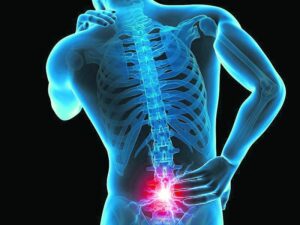Lower back pain is a common complaint among adults, often causing significant discomfort and disruption to daily activities. While mild cases may resolve with rest and conservative treatments, more persistent or severe pain often necessitates specialized care. As such, the role of a lower back pain doctor, or spine specialist, becomes crucial in diagnosing, managing, and treating this condition. This blog post aims to shed light on the integral role these specialists play, their methods of diagnosis, treatment strategies, and how they can help you regain your quality of life.
Contents
What Is The Importance Of a Lower Back Pain Doctor?
 A lower back pain doctor, often a specialist in orthopedics, neurology, or physiatry, plays a critical role in diagnosing, treating, and managing lower back pain. Their importance cannot be overstated for several reasons:
A lower back pain doctor, often a specialist in orthopedics, neurology, or physiatry, plays a critical role in diagnosing, treating, and managing lower back pain. Their importance cannot be overstated for several reasons:
- Expert Diagnosis
Lower back pain can result from a wide range of conditions, including muscle or ligament strain, herniated discs, sciatica, and osteoarthritis. Even conditions like kidney stones or infections. A lower back pain doctor has the specialized knowledge and training to accurately diagnose the cause of your pain.
- Access to Advanced Testing
These specialists have access to and can interpret sophisticated diagnostic tools such as MRIs, CT scans, and X-rays, which can help pinpoint the exact source of pain. They can also conduct nerve conduction studies or electromyography to diagnose nerve and muscle disorders.
- Personalized Treatment Plans
A lower back pain doctor can devise a customized treatment plan suited to your specific condition, age, overall health, and lifestyle. This plan can involve a combination of physical therapy, medication, lifestyle modifications, and even surgery.
- Prevention and Rehabilitation
Beyond treatment, these doctors provide valuable guidance on preventing further back problems, including correct posture, ergonomic advice, and appropriate exercises. They also oversee the rehabilitation process to ensure a successful recovery post-treatment or surgery.
- Management of Chronic Pain
In cases of chronic back pain, a lower back pain doctor’s role is even more critical. They can help manage the long-term aspects of pain, working with patients to improve function and quality of life. Often coordinating with other healthcare professionals such as psychologists, physical therapists, and occupational therapists.
By understanding your condition and providing targeted treatments, a lower back pain doctor can help you regain your quality of life. And return to your normal activities with less discomfort.
What Is The Best Doctor To See For Lower Back Pain?
When dealing with lower back pain, you may encounter several types of doctors depending on the nature and severity of your pain. The best doctor to see can depend on various factors. Here are a few types of doctors who commonly treat lower back pain:
Primary Care Physicians (PCPs)
These are your first line of defense. They can assess your condition and provide initial treatment options such as rest, physical therapy referrals, and pain relievers. If your pain persists despite these interventions, they can refer you to a specialist.
Physiatrists
Also known as Physical Medicine and Rehabilitation physicians, they specialize in non-surgical treatments for conditions that affect movement, such as back pain. They provide a comprehensive treatment plan that could include physical therapy, medications, and injections.
Orthopedic Surgeons
These surgeons specialize in conditions related to the musculoskeletal system, which includes the spine. They can diagnose and treat back pain and can perform surgery if necessary.
Rheumatologists
If your back pain is caused by an inflammatory process or an autoimmune condition, a rheumatologist would be a good choice. These specialists treat conditions like arthritis, rheumatoid arthritis, and ankylosing spondylitis.
Neurologists
If your back pain is associated with nerve-related symptoms. Such as numbness, tingling, or weakness, a neurologist may be best suited to diagnose and treat your condition. They can also address conditions such as sciatica or nerve impingement.
Pain Management Specialists
These doctors focus on managing chronic pain conditions. And may use a variety of treatments ranging from medication management to nerve blocks and other interventional procedures.
It’s important to remember that the “best” doctor for lower back pain may not be the same for everyone. As it depends on individual circumstances and the underlying cause of the pain. Always start with your primary care doctor, and they can guide you to the right specialist for your needs.
How Does a Lower Back Pain Doctor Diagnose Your Condition?
 A lower back pain doctor will use a variety of techniques to diagnose the cause of your lower back pain. That can range from simple physical exams to advanced imaging technologies. Here are the typical steps:
A lower back pain doctor will use a variety of techniques to diagnose the cause of your lower back pain. That can range from simple physical exams to advanced imaging technologies. Here are the typical steps:
Patient Interview and Medical History
The first step in the diagnostic process usually involves an in-depth discussion about your symptoms, medical history, lifestyle, and any potential triggers for your back pain. This may include questions about when the pain started, what makes it better or worse, whether you’ve had any recent injuries, and whether you have any other symptoms like numbness or weakness.
Physical Examination
The doctor will likely perform a physical exam to assess your pain and mobility. This could involve observing your posture, range of motion, and physical condition, checking for areas of tenderness, and examining your back’s alignment. The doctor might also conduct neurological exams to test your reflexes, muscle strength, and sensation. Especially if your pain is associated with nerve involvement.
Diagnostic Testing
Depending on the results of your history and physical exam, your doctor may order diagnostic tests such as:
- X-rays: These images can show alignment issues and changes to the bones, like fractures or osteoarthritis.
- MRI or CT Scans: These more detailed images can reveal problems with the discs, muscles, tendons, nerves, and blood vessels.
- Blood tests: These can help identify inflammation or infection that might be causing or contributing to your pain.
- Nerve studies (Electromyography or EMG and Nerve Conduction Studies): These tests can help confirm nerve compression caused by herniated disks or narrowing of your spinal canal (spinal stenosis).
Diagnostic Procedures
In some cases, if the cause of your pain is still unclear, your doctor might recommend diagnostic procedures such as nerve blocks or discograms. These tests can help your doctor better understand which spinal structures are causing your pain.
It’s important to remember that the process of diagnosing lower back pain can sometimes take time, as your doctor will want to rule out various potential causes to find the right treatment plan for you. The goal is not just to alleviate the symptoms but also to address the underlying cause of the pain to prevent future occurrences.
What Treatment Approaches Do They Use?
Lower back pain doctors utilize a wide range of treatment approaches based on the cause and severity of your pain. As well as your overall health and lifestyle. Here are several common treatment methods:
Conservative Management
This is typically the first line of treatment and can include:
- Physical Therapy: Tailored exercises and stretches can help alleviate pain and strengthen the muscles that support your back. Physical therapists can also teach you how to improve your posture and reduce strain on your back.
- Medications: Over-the-counter pain relievers, nonsteroidal anti-inflammatory drugs (NSAIDs), muscle relaxants, or topical creams and ointments can help relieve pain. For more severe pain, doctors might prescribe stronger medications.
- Lifestyle Changes: Recommendations might include maintaining a healthy weight, quitting smoking, and avoiding activities that strain your back.
Interventional Treatments
If conservative treatments aren’t effective, your doctor may recommend:
- Injections: Epidural steroid injections, nerve blocks, or facet joint injections can provide temporary relief by delivering anti-inflammatory medication directly to the source of the pain.
- Radiofrequency Ablation (RFA): This procedure uses an electrical current to heat up a small area of nerve tissue to decrease pain signals from that specific area.
Surgery
Surgery is usually considered only when conservative treatments haven’t worked and if the pain is persistent and disabling. Types of surgery include:
- Microdiscectomy: This is a minimally invasive procedure to remove the portion of a herniated disc that’s pressing on a nerve.
- Laminectomy: This procedure involves removing part of the bone, bone spurs, or ligaments in your back to relieve pressure on spinal nerves.
- Spinal Fusion: In this procedure, two or more vertebrae are permanently connected to stabilize the spine and reduce pain.
Complementary Therapies
 Some people find relief from complementary therapies like acupuncture, massage, yoga, and biofeedback.
Some people find relief from complementary therapies like acupuncture, massage, yoga, and biofeedback.
The goal of treatment is not only to alleviate pain but also to teach you strategies to prevent re-injury and avoid back pain in the future. Therefore, part of the treatment may also include patient education about the condition and how to best manage it.
Remember, each patient is unique, and treatment plans are individualized to meet the patient’s specific needs and circumstances. It’s essential to discuss all options with your doctor to choose the best approach for you.
Conclusion
In conclusion, lower back pain is a widespread condition that can significantly affect one’s quality of life, but with the right guidance and treatment, it is manageable and often treatable. A specialist in lower back pain plays a crucial role in this process, using a multitude of diagnostic tools and therapeutic approaches, ranging from conservative management to interventional treatments, and in severe cases, surgery.
Understanding the role of these doctors, the diagnostic process and the variety of available treatment options empowers you to take an active role in your health care. Although living with lower back pain can be challenging. Remember that help is available, you can work towards a healthier, pain-free future.
If you’re experiencing Back pain, physical therapy for back pain at PhysioMantra can help: Book an online physical therapy session.



